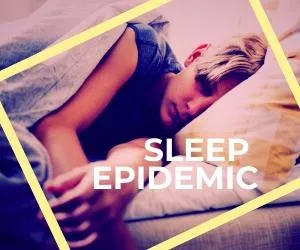The Social Communication Blog
By Linda Boverman

Is Your Child A Victim of The Sleep Deprivation Epidemic?
We know lack of sleep occurs in young children, teens, and adults. This article focuses on children and teens. Research is showing that lack of sleep is most serious in teens.
Nanci Yuan, MD, director of the Stanford Children’s Health Sleep Center called the problem of tired teens a public health epidemic.
The following highlights the problem:
“According to a 2006 National Sleep Foundation poll, the organization’s most recent survey of teen sleep, more than 87 percent of high school students in the United States get far less than the recommended eight to 10 hours, and the amount of time they sleep is decreasing — a serious threat to their health, safety and academic success.”

The list of negative consequences of sleep deprivation in our teens and young children includes:
Inability to concentrate or a “fuzzy” head
Poor grades
Fatigue and drowsiness
Anxiety
Depression
Thoughts of suicide
Suicidal attempts
Lack of focus
Reduced abilities to regulate emotions
Lower inhibition
Moodiness
Forgetfulness
Lack of motivation
Irritability
Difficulty learning new concepts
Clumsiness
Increased appetite and carbohydrate cravings
Weight gain
Impaired judgement/create mental lapses
Cause traffic accidents
Impair visual perception*
If you observe any of these in your teen, there are a number of simple steps that can help your child:
1. Daily or almost daily exercise that raises the heart rate to the aerobic range is beneficial for sleep as well as emotional well-being and physical health. But not before bed. Moderate movement such as light stretching or a walk around the block is best then. In the morning, even spending ten to twenty minutes outside has shown to be helpful.
2. Create transition time between wakefulness and sleep. If our brains don’t calm before bed, they may need to take time in bed before being able to fall asleep.
Some activities that may help are:

Light Stretching

Boring Reading

Taking a Shower or Bath

Writing in a Sleep Diary
These activities may also be helpful if you wake up and can’t go to sleep. Get up and do them then go back to bed.
3. Ideally, we want to:
Keep the bed for sleeping.
We can help this along by setting the bedroom up only for sleeping. Reading, all technology, napping should all be done in a different room. If we can’t give up reading in bed, read only print books. Lower the lights. Sleep in true darkness—even the light from a digital clock can be intrusive. Natural light—stars, moon, sunlight—is fine. Lower room temperature to 65 degrees at night.
When falling asleep or in the middle of the night, a thought comes that begs remembering, write it down. That way, it will have found a safe place and no longer need to distract the brain.
4. Mindfulness is a beneficial strategy for inducing and maintaining sleep. Part of the reason may be because 60% of sleep problems are due to stress.
Fifteen minutes of mindful breathing before bed calms and helps the brain manage stress.
It can be as simple as breathing in "calm" through the nose and breathing out "anxiety" through the mouth. Progressive relaxation—tightening and releasing muscles, starting with the feet and moving up the body a section at a time—has also had positive results. As does practicing gratitude and listening to soft music.
5. If your teen calls you a "tech fascist", it's a compliment!
Light from devices used for nighttime reading can interfere with sleep; this is why a printed book is better for nighttime reading.
The blue light on the phone is like daylight and pushes back the melatonin.
For children ages 6 and older, place limits on the time using media and the types of media, makes sure media does not take the place of adequate sleep, physical activity and other behaviors essential to health.
Consider having a family charging system where devices go to sleep at night.
Higher users have more depression, anxiety, lower self-esteem, sleep issues, and attentional challenges.
“Not social media itself but 60% of psychological distress from how it exposes them to lack of sleep and cyber bullying is the threat. Key message: get enough sleep, don’t lose contact with your friends in real life, and physical activity is important for mental health and well-being.”
Children need to turn off all technology 30-90 minutes before bed—adults 30 minutes—and do relaxing activities during that time. You might want to say something like, “I understand you want to continue playing video games, but we don’t play an hour before bedtime…. It makes your brain so active it’s hard to prepare for sleep.”
No screens in the bedroom. Period. Ever, says Chris Anderson, the editor of Wired. He's the parent who said his kids call him and his wife tech fascists. I’m guessing he wears those words as a badge of honor. He sees the dangers of tech firsthand and believes we need to set limits for our children and ourselves.
Model conscious use of screen time. Why would our children do what we want them to do if we don’t do it ourselves?
Research shows that adequate sleep, exercise, and face-to-face interaction are at the top of the list of activities that promote health, mentally and physically, in ourselves and our children.
We have limited ability to get schools to give less homework or start later to accommodate teenagers’ natural sleep rhythms, but we can influence habits—ours and those of our children.
Habits are hard to change, but knowing getting enough sleep is crucial for emotional well-being and physical health in ourselves and our children can help us make the necessary changes.
*If you care to go deeper into the subject, an excellent source is an article by Ruthann Richter, director of medical relations for Stanford Medical School’s Office of Communication and Public Affairs.
https://med.stanford.edu/news/all-news/2015/10/among-teens-sleep-deprivation-an-epidemic.html
Coming soon is a series of articles on screen time and social media.

Copyright 2023 . All rights reserved
lindaboverman@gmail.com
(213) 804-7750

